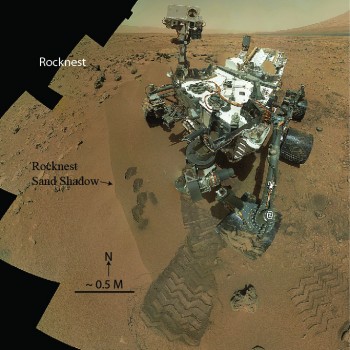Sediments in Gale Crater Similar to Deposits at Two Other Sites on Mars
September 26, 2013

Scientists using instruments on the Mars rover Curiosity have determined that a deposit of wind-blown sand and dust in Gale Crater is chemically and mineralogically similar to deposits previously analyzed by the Mars Exploration Rovers Spirit and Opportunity at two other sites on the red planet. Sediments in all three locations were produced by the physical weathering of volcanic rocks called basalts. The findings are published along with four other articles highlighting results from Curiosity this week in the journal Science.
“These results are consistent with a wealth of other evidence that the Martian crust is primarily basalt and that physical weathering is much more important than chemical weathering,” says Gary Kocurek, professor at the University of Texas at Austin’s Jackson School of Geosciences and co-author of the new study.
Chemical weathering involves breaking down rocks by changing their mineral composition, usually in the presence of water. Because the surface of Mars has been dry for millions, or perhaps billions, of years, most weathering happens when rocks shatter from temperature changes, are hit by meteorites or are blasted by strong winds—all physical processes that break rocks down into smaller pieces.
The team, led by David Blake, senior staff scientist at the NASA Ames Research Center, propose two possible explanations for the similarity of sediments at the three sites. One is that strong, global winds pick up and mix local sediments into a globally similar mixture. Another explanation might be that the basalts that spawned the sediments are similar everywhere on the planet.
The deposit analyzed in this study, the Rocknest sand shadow, is an accumulation of wind-blown sediment deposited in the lower-velocity lee of an obstacle in the path of the wind. Soon after landing in Gale Crater in August 2012, Curiosity dug five scoops of loose material from Rocknest and analyzed them with five instruments.
“This is a big deal,” says Kocurek. “We’re exploring another planet with a rover that acts like a geologist and carries its own sophisticated laboratory around. We know so little about Mars that anything we find is important.”
The paper, titled “Curiosity at Gale Crater, Mars: Characterization and Analysis of the Rocknest Sand Shadow,” appears in the Sep. 27, 2013 edition of the journal Science.
